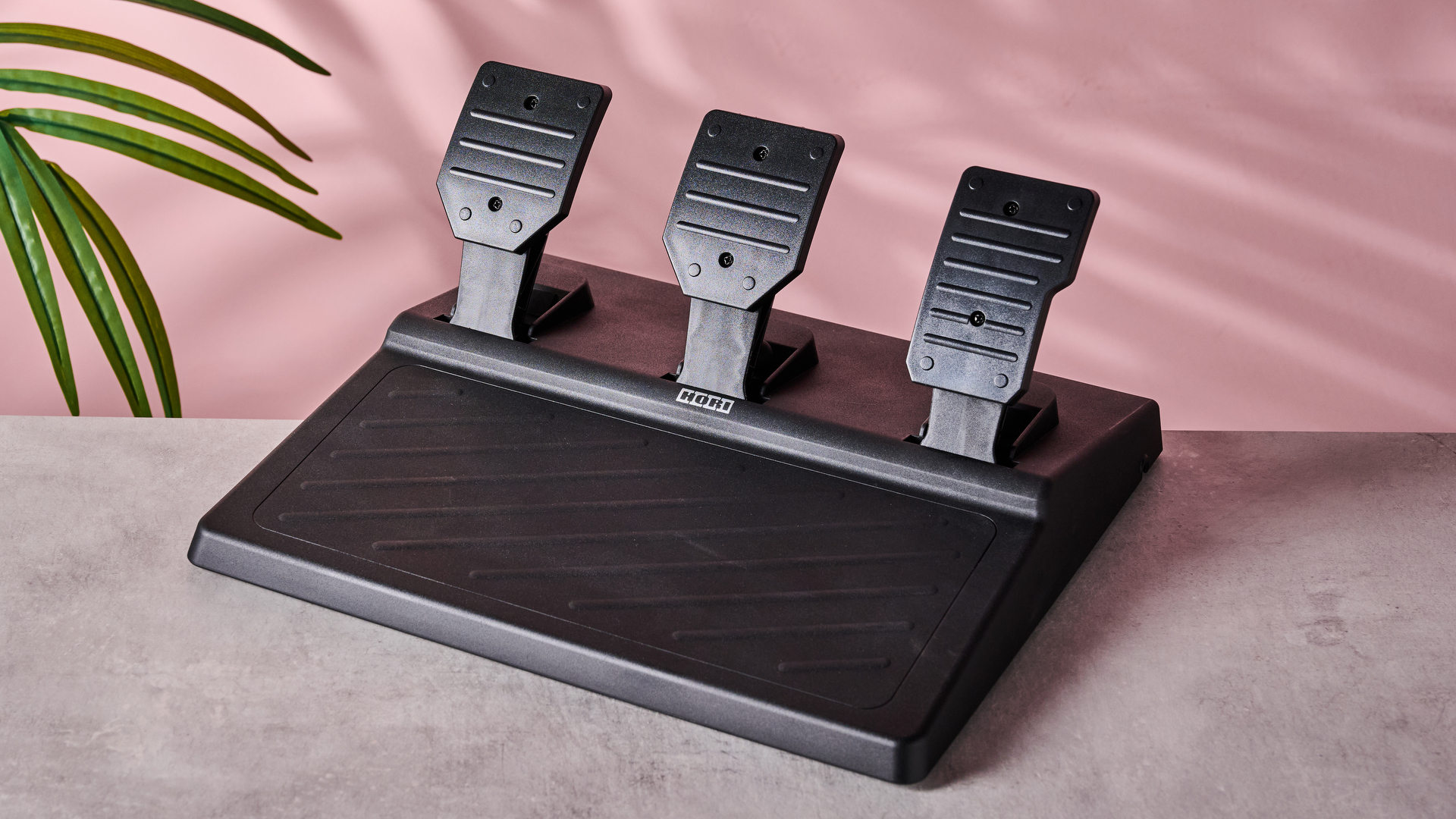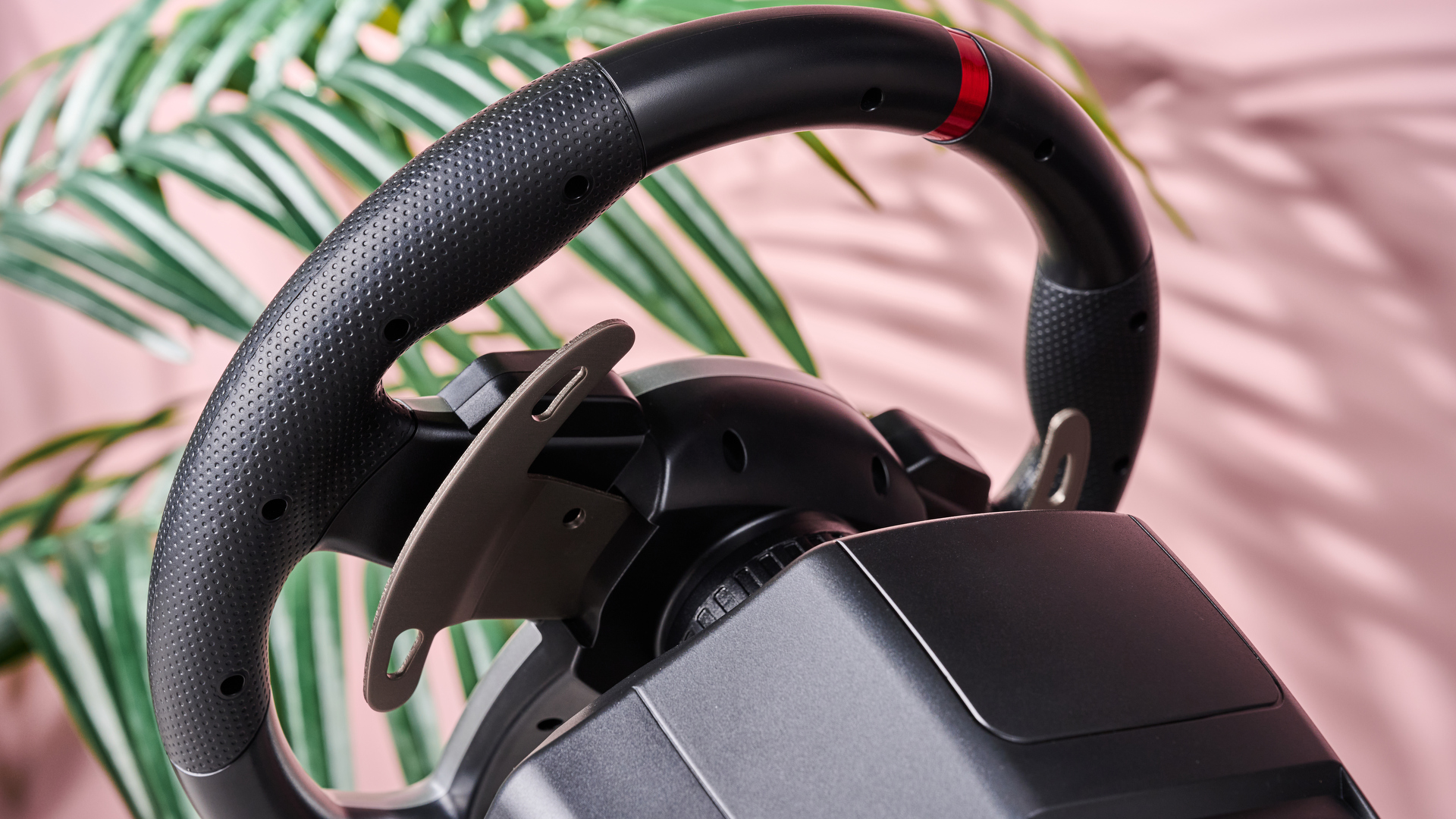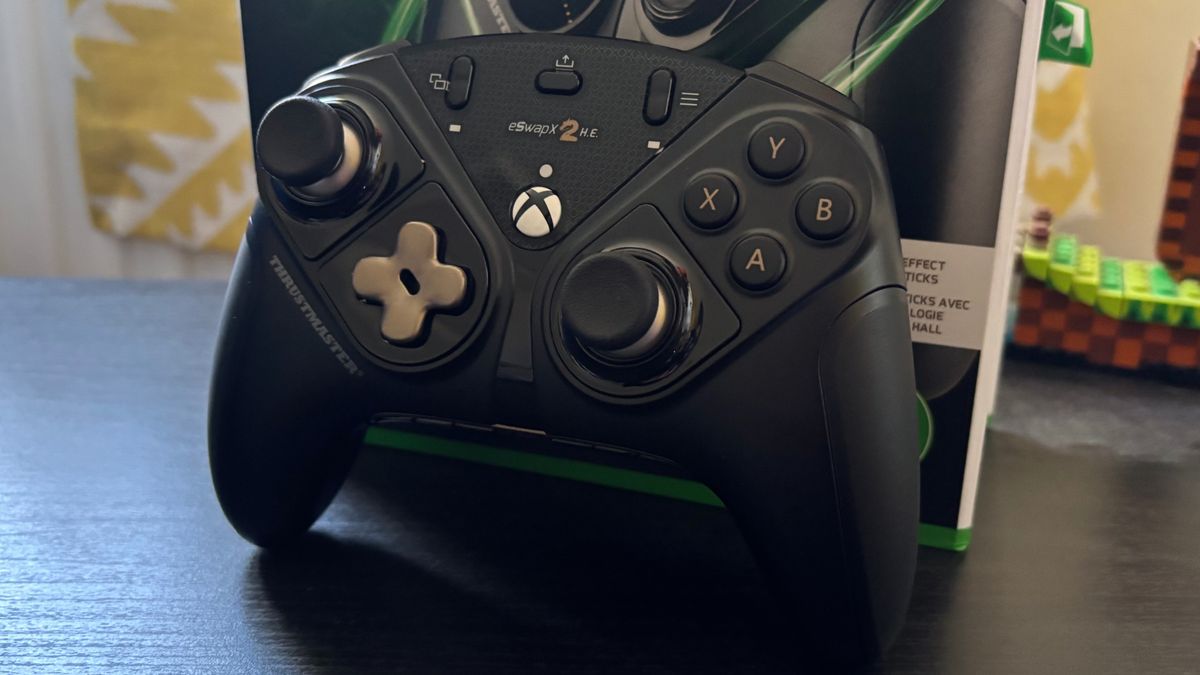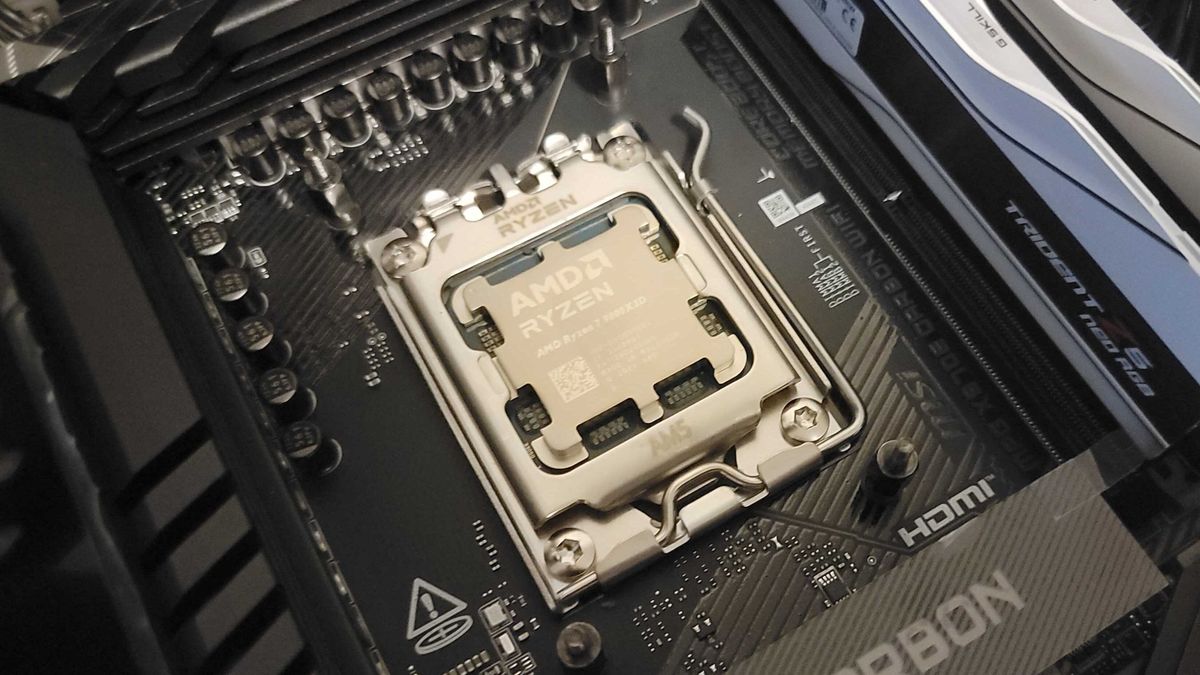Hori Force Feedback Racing Wheel DLX: One-minute review
The Hori Force Feedback Racing Wheel DLX is a racing wheel designed for Xbox Series X and Series S consoles, although it’s also compatible with the Xbox One. I was immediately taken with the design of the wheel itself. It has an ergonomic shape, and the soft-grip material on the sides are comfortable and provide security. The indents that allow your thumbs to rest on are also a nice touch.
Build quality is also quite good, with the paddles being a particular highlight, rivaling what the best racing wheels have to offer. The pedal set is less impressive, but it functions as intended and remains stable on carpet floors.
The Force Feedback Racing Wheel DLX is pleasingly light, too, which helps with installation, something that's further aided by the amenable clamping system and easily accessible ports. It can also be attached to racing wheel stands, although no screws are provided for this.
There’s an Xbox app for adjusting its various force feedback and sensitivity settings, but these are more basic than those provided in the software of other racing wheels, such as Thrustmaster’s. While there's also a remapping feature, this is limited to just the paddles and the two central buttons on either side of the wheel.
In action, the Force Feedback Racing Wheel DLX failed to impress me all that much. The steering isn’t as smooth or as precise as I would’ve liked, which seemed to be more of a problem for certain games than others. In some games, it didn’t seem to track accurately, creating a sense of lag and disconnectedness from the cars I was driving.
The force feedback isn’t particularly nuanced, either, and the light throttle pedal lacks feedback. Another issue I experienced was that my thumbs would often become trapped between the rim and the paddles when making sharp turns – an ergonomic faux pas that really shouldn’t exist.
On the face of it, the Force Feedback Racing Wheel DLX looks like good value considering its low price. But the performance isn’t quite there, and there are a few even cheaper wheels that perform better, such as the Thrustmaster T128. This also has the advantage of working with multiple platforms, PC included.

Hori Force Feedback Racing Wheel DLX review: Price and availability
- $299.99 / £299.99 (around AU$460)
- Reasonable price...
- ...but rivals are better value
The Hori Force Feedback Racing Wheel DLX costs $299.99 / £299.99 (about AU$460) and is available now for Xbox platforms only. There’s only one colorway and one wheel type.
This isn’t a bad price for a racing wheel, although there are a few that beat it. For instance, the Thrustmaster T128 is considerably cheaper, but performs much better in my opinion. Unlike the Force Feedback Racing Wheel DLX, the T128 is compatible with multiple platforms, too.
If you’re looking for one of the best Xbox racing wheels, the Logitech G923 sits at the top of the pile as far as we’re concerned. It's more expensive than the Force Feedback Racing Wheel DLX, but not by a huge margin, and offers a much better sim racing experience. It’s also compatible with PC, and a PlayStation variant is available as well.
Hori Force Feedback Racing Wheel DLX review: Specs
Swipe to scroll horizontally
Price | $299.99 / £299.99 (about AU$460) |
Weight | 10.6lbs / 4.8kg |
Features | Three-pedal set, profile switch button |
Connection type | USB-A |
Compatibility | Xbox Series X|S, Xbox One |
Software | Hori FFB RWD Device Manager for Xbox |
Hori Force Feedback Racing Wheel DLX review: Design and features
- Ergonomic wheel shape
- Good build quality
- Easy to install
I was immediately taken with the wheel design of the Force Feedback Racing Wheel DLX. It has a comfortable thickness, and the thumb slots and soft grip material make it a pleasure to hold. The square bottom was also something I welcomed, making it easy to discern orientation at any given moment.
The buttons are of a reasonable quality, although they’re not as tactile or as damped as those you’ll find on the best Xbox controllers. Still, the thoughtful layout makes them easy to use, although the RB and LB placement – they’re in the middle of the circular button clusters on either side – felt a little unintuitive to me. Thankfully, these central buttons can be remapped.
There’s also a useful button for switching saved profiles configured in the Hori FFB RWD Device Manager Xbox app. The LED at the center of the wheel changes color depending on which of the eight profile slots you have selected.
The paddle shifters are equally well-designed, with a long but thin profile that makes them easy to get your fingers behind. Their metal material looks and feels premium as well.
Unfortunately, the pedal set looks and feels less so, with cheaper-seeming plastics and a lightness that doesn’t instill much confidence. However, I found they remained stable enough when lying on a carpet floor.

Installing the Force Feedback Racing Wheel DLX proved easy enough. The wheel base is quite light, which makes the process less laborious, while the clamp is easy to attach to a desk. A single screw is all that’s required, and it features a maneuverable lever that makes it easier to tighten. The whole process is significantly less onerous than that of certain Thrustmaster wheels I’ve tested.
Also, there are screw holes underneath the wheel base and the pedal set for fixing the Force Feedback Racing Wheel DLX to a racing wheel stand, although it’s a shame that the requisite M6 screws aren’t provided.
Since this is an Xbox wheel, it’s pretty much plug-and-play as far as setup is concerned, although the aforementioned Xbox app is required for firmware updates and making certain adjustments.
These adjustments aren’t as rich as those you’ll find in other racing wheel software. There’s one slider for the force feedback strength, and a couple for the deadzones and sensitivities pertaining to steering and each pedal. There are also some rebinding options for the wheel button – but only for the LB and RB buttons and the paddles.
Hori Force Feedback Racing Wheel DLX review: Performance
- Inconsistent response
- Numb throttle pedal
- Ergonomic issue with Paddles
I found the Force Feedback Racing Wheel DLX was inconsistent in its performance: depending on the game I played, steering inputs ranged in their responsiveness and accuracy.
When playing Assetto Corsa, it did quite well on both of these fronts, my inputs tracking well with the in-game movements. However, steering was still a little grainy, which is especially noticeable when making small steering corrections.
Performance was worse, however, when playing Forza Motorsport. Here, the tracking seemed off, producing a lagging effect. Things improved when adjusting certain in-game settings, such as the steering linearity and self-centering parameters, but I still couldn’t completely shake the sensation of feeling disconnected from the car.

The force feedback also seemed worse in Forza Motorsport than in Assetto Corsa. In the former, it again felt like it wasn’t matching up with what was happening in-game. It also lacks much subtlety, jumping from no vibration to maximum intensity without much provocation – and again seeming at odds with the events taking place within the game itself.
Regardless of what game you play, there are a few notable constants. The paddles, despite being satisfyingly snappy and tactile, are too close behind the wheel. This meant that whenever I turned the wheel at angles close to and beyond 180 degrees, my thumbs would get stuck between the outer edge of the paddles and the inner edge of the wheel rim.
Also, I found the throttle a little too light, failing to provide as much feedback as I would’ve liked, although it wasn’t quite as numb as some other throttles I’ve tried. The brake pedal offers more feedback thanks to its increased resistance, but it's still relatively light.
Should I buy the Hori Force Feedback Racing Wheel DLX?

Buy it if...
You want a good wheel design
I liked the ergonomic thumb slots and soft-grip material, as well as the square-off bottom, which helps to indicate the orientation of the wheel.
You want a racing wheel that’s easy to use
Installation is easy thanks to the lightweight construction and clamping system, while the companion app can set you up in no time.
Don't buy it if...
You’ll be making lots of sharp turns
When making large turns, my thumbs would often get jammed between the wheel and the paddles, which is obviously concerning.
You want compatibility with multiple platforms
The Force Feedback Racing Wheel DLX only works on Xbox platforms, so if you’re on PlayStation or after one of the best PC racing wheels, you’ll need to look elsewhere.
Hori Force Feedback Racing Wheel DLX review: also consider
Here are some alternatives to the Hori Force Feedback Racing Wheel DLX if you want support for more platforms:
Swipe to scroll horizontally
Price | $299.99 / £299.99 (about AU$460) | $199.99 / £149.99 (around AU$312) | $349.99 / £379.99 / AU$649.95 |
Weight | 10.6lbs / 4.8kg | 9lbs / 5kg | 12lbs / 5.4kg |
Features | Three-pedal set, profile switch button | Handbrake buttons, 4 engine speed display RPM LEDs | Rotary dial, three-pedal base |
Connection type | USB-A | USB-A | USB-A |
Compatibility | Xbox Series X|S, Xbox One | Xbox Series X|S, Xbox One, PlayStation 5, PlayStation 4, PC | Xbox Series X|S, Xbox One, PlayStation 5, PlayStation 4, PC |
Thrustmaster T128
The T128 is a wheel designed for the budget-conscious. It might have a less-than stellar design, but it all functions well, and the performance surprised me given how cheap it is. There aren’t many better racing wheels at this price. Read our full Thrustmaster T128 review.
Logitech G923
Another big name in the racing wheel market, the Logitech G923 is a superb all-rounder. Not only is it one of the best Xbox racing wheels, we also think it’s one of the best PS5 racing wheels, thanks to the model variant that’s compatible with Sony’s console. Read our full Logitech G923 review.
How I tested the Hori Force Feedback Racing Wheel DLX
- Tested for a few days
- Played various racing sims
- Racing wheel reviewing experience
I tested the Force Feedback Racing Wheel DLX for a few days on an Xbox Series X. I made sure to try out all of its features where possible and used its companion app to see what functions and adjustments it had to offer.
I played Forza Motorsport and Assetto Corsa, two racing games for Xbox offering different levels of simulation, and therefore together provide a comprehensive test for racing wheels.
I have been a fan of racing sims for decades, and have tested a number of racing wheels across a range of brands, styles, and price points.
- First reviewed: July 2025
- Read more about how we test










 English (US) ·
English (US) ·